Lecture XIV.a--
The Electronic
Frontier
-
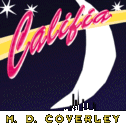
Califia
by M.D. Coverley - This is Your Instructor, yours truly, me (some students
have been surprised!!)
-
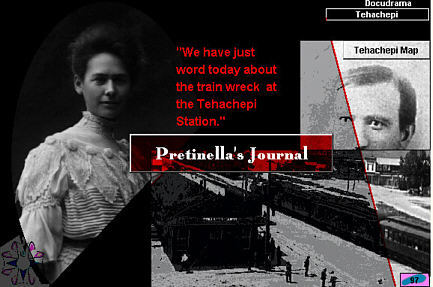
Califia comes along at what is
being called "third wave" hypertext - that is, it has text,
image, sound, and a navigation system that is especially designed for the
fictional piece. As such, it represents some new developments - and
a substantially different way of looking at the hypermedia reading
experience. If you just want to see the outline of the book, I have
some material up at my web pages: Califia
Preview. This preview offers insight into the main sections of
Califia, a little history on the technical issues, and some fine critical
material. I also have posted an essay on the historical aspects of
Califia at: Califia
History.
Works by M.D. Coverley
Fiction--as M.D. Coverley
CD-ROM Novels:
Califia, CD-ROM-format, hypermedia, interactive novel. Eastgate
Systems, Boston, MA, June 2000.
The Book of Going Forth by Day, electronic hypermedia
novel-in-progress.
Hyperfictions on the Web:
"Tide-Land." Beehive, vol.3, December 2000. On-line:
<http://beehive.temporalimage.com/content_apps34/app_b.html>
"Tumblers." Riding the Meridian, December 2000.
On-line: <http://califia.us/tumblers/>
"Errand Upon Which We Came." With Stephanie Strickland. in Cauldron and Net, 2000
"Default Lives." Cauldron and Net, 2000
"Universal Resource Locator." Iowa Review Web, October
2000. On-line: <http://www.uiowa.edu/~iareview/tirweb/hypermedia/md_coverley2/index.html>
"Eclipse Louisiana." Cauldron and Net, April 2000.
On-line: <http://www.studiocleo.com/cauldron/volume2/contents/index.html>.
"Rain Frames." Aileron, February 2000. On-line:
<http://unblinkingeye.com/Poetry/Aileron/Poetry2/Coverley/rainfr/rainfr.htm>.
"Endless Suburbs." Iowa Review Web. October 1999.
On-line: <http://www/uiowa.edu/~iareview/tirweb/tirweb.htm>.
"Fibonacci's Daughter." New River Literary Magazine
#7, 2000. Originally created as an on-line writing project with trAce,
Nottingham Trent Universtiy, U.K. On-line: < http://www.cddc.vt.edu/journals/newriver/>.
"Pao-Lien and the Cave Dragon, Wu." Selection for Christy
Sheffield Sanford's "Millennium" project for trAce,
Nottingham Trent University, U.K., 1999. On-line: <http://trace.ntu.ac.uk/writers/sanford/millennium.html>.
"To Be Here As Stone Is." Poetry from True North, in
collaboration with Stephanie Strickland. Riding the Meridian #2,
1999.
"Life in the Chocolate Mountains." Salt Hill #7--Literary
Magazine of Syracuse University. Spring, 1999. On-line: <http://www.hypertxt.com/sh/no7/choc/achoc.htm>.
"Egyptian E-Mail." Enterzone Magazine #14, June, 1998.
On-line: <http://ezone.org/ez/e14/articles/coverly/egypt.html>.
"The Little Lacemaker, Elys." From The Book of Days of
Madame de Lafayette, Christy Sheffield Sanford, project director,
collaborative web project. 1997-98. On-line: <http://gnv.fdt.net/~christys/Coverley/elys_1.html>.
"The Probability of Earthquake." Blast 5. Produced by
the Alt-X Foundation, New York. 1997-98. On-line at: <http://artnetweb.com/blast5/anacep/earth_1.htm>.
"The $500 Rolls Royce." Orange Coast, October, 1995.
Formerly on-line: <http://orangecoast.com>. Now on-line: <http://califia.us/royce.htm>.
"The Virtual Mausoleum." Orange Coast, September,
1995. Formerly on line: <http://orangecoast.com/virtual.html>. Now
on-line: <http://califia.us/Virtual/virtualtrans.htm>.
"The Neverending Fairy Tale." Orange Coast, June,
1995. Formerly on-line: <http://orangecoast.com/virtual.html>.
Now on-line: <http://califia.us/Fairyend.htm>.
"Love and the Dragonfly," (novel excerpt) The Register,
July, 1992. On-line: <http://califia.us/Dragon/dmoon.htm>.
Work in progress: "Fingerprints on Digital Glass"
collection of short electronic hypermedia stories for the WWW. On-line:
<http://califia.us/home.htm>.
Curated Collections:
"Jumpin' at the Diner" (with Jennifer Ley). Riding the
Meridian, December, 2000. 40 men in hypermedia web literature.
On-line: <http://www.heelstone.com/meridian/>.
"The Progressive Dinner Party" (with Carolyn Guertin). Riding
the Meridian, Spring, 2000. 39 women in hypermedia literature on the
WWW.
Academic Publications--as Marjorie C. Luesebrink
Print Publications:
"The Moment in Hypertext: A Brief Lexicon of Time." Proceedings
of the Ninth ACM Conference on Hypertext and Hypermedia, 1998. (SIGLINK)
"Code Egyptian Blue: Crossover Platforms in Hypertext
Fiction." Proceedings of the CyberMountain Colloquium--Denver
Colorado. Larsen, D. and Nürnberg, P. J. (eds.) 1999. Technical
Report AUE-CS-99-05, Aalborg University Esbjerg. On line: <http://www.cs.aue.auc.dk/~pnuern/papers/cymt.final/>
"Walk Four Ways." Co-authored with Carolyn Guyer, Peg
Syverson, Michael Joyce. Pre Text, University of Texas, Austin.
1997.
"Upward, Beyond the Constant Flow, There was Moondling: Writers,
Rhetoric, and Technology in Hypertext Fiction." The Elephant Ear,
Spring, 1996.
"The Grateful Dead Legendstock." Perspectives on the
Grateful Dead. Robert Weiner, ed. Greenwood Press. Fall, 1999.
Online Publications:
"The Personalization of Complexity." Forthcoming in frAme,
a publication of trAce Online, University of Nottingham, UK.
The Califia Story
Califia is technically an
interactive, hypermedia novel. It has over 800 screens, 350
pages of text, 2400 images, 30 songs. Also, Three Narrating Characters, Four Directions of the Compass, Star Charts, Map Case, Archives
Files.
The story begins when Augusta
Summerland's father dies, and she begins digging in the back yard of the
house in Whitley Heights to find the gold coins she believes are buried
there. Soon, she is joined by Kaye Beveridge and Calvin, and,
together, the three begin a larger search for a lost mine - the mine of
Califia. Five generations of their families have, it turns out, been
involved with the Califia mine - and each generation has suffered the
usual California dust-up. Of course, a search for gold in the failed
paradise of Los Angeles can turn up almost anything!
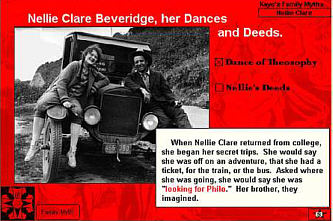
There are several aspects of
Califia that continue the pioneering work of other women writers working
in e-lit. As we have seen, these include:
Simultaneity
Multiplicity of Voice
Layers of History
Image and Sound as Text
Freedom of Interest for the
Reader
Shape of Reality
For our on-line discussion,
perhaps it would be helpful to examine these ideas in the light of the
historical treatment of women in the novel. From the essay on
Califia History:
The Califia stories occur in specific historic periods and in actual locations. Yet, while
Califia thereby seems to fall easily into a category we might call historical fiction, my intention was to use factual time and place in a somewhat different manner. The historical material in Califia is primarily neither background nor decoration nor local color (although I hope these functions obtain); rather, history itself is a major thematic
element of the novel. As such, I used different techniques of matching history to the
shape of the narrative, depending on which aspect of our understanding of history I
was attempting to foreground.
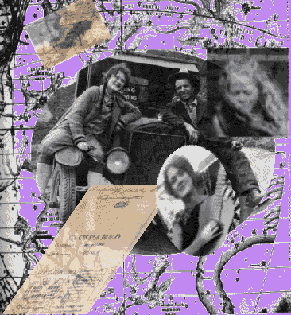
Overall, it was necessary to employ historical time in order to portray the ways in
which characters (and real people) might differ in their perception of events and yet
remain within a larger truth. I hoped to use history to validate alternative histories and
include marginalized voices. Only if I used a widely acknowledged historical
framework and verifiable details, I felt, could I represent multiple, layered versions of
experience, each of them fundamentally "true."
For example, the "mythic" time frame (which is explored on Kaye's path) begins with
the earliest legends of islands and extends to a limited knowledge of the future, since
Kaye has contact with the "spirits." Even though Kaye is unquestionably a California
visionary, she is not an unreliable narrator. Her perception is oriented to the long view
of history, a certain selection of cosmic aspects, and a sense of the rhythms of the
natural elements - all confirmed by facts. My research, while not nearly so methodical
as for an academic treatise, was extensive. The island legend material came from a
number of texts, including Marvelous Possessions: the Wonder of the New World
by Stephen Greenblatt, The Island of California by Dora Beale Polk, and Cabeza
de Vaca's Adventures in the Unknown Interior of America translated and edited
by Cyclone Covey. [A partial bibliography is included at the end of these notes.]
The interface between real history and fiction was negotiable, but I attempted to locate
it as close to the bare bones of the "invented" plot as possible. The earthquakes (listed
in Kaye's "Geological Certainties" in The Journey South) of 1857 and 1883 in the
Tejon and the Tehachapi (1) actually happened.
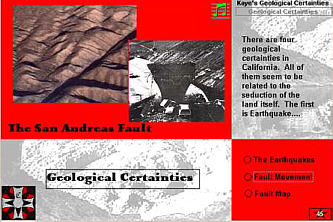
Also of historical record is the Tehachapi train wreck of January 20, 1883 (The History of Los Angeles, City and
County). Although the eyewitness accounts do not mention an earthquake, the reports
conflict about the cause of the accident. It seemed reasonable to me to suppose that,
since the ground was particularly unstable that year, a quake could have been a factor.
When constructing the tale of the lost Califia mine, I started with the real earthquakes
that surely could have collapsed a mine and obscured the entrance, and then built the
story around those dates. Kaye tells the story of "The Probability of Earthquake,"
which includes portions of the history of the mine.
Many readers have supposed that the Califia mine was a complete fiction, since gold
is usually associated with the Sierra Nevada. However, the mountains north of Los
Angeles were the site of the first gold discovery in California in 1842 (The Oak of the
Golden Dream link in The Journey East, Augusta's Path). And, fringe folks (like my
characters) continued to hope for strikes in the Tehachapi Mountains as recently as
yesterday. The known mines in the Tehachapi do not correspond exactly with the
fictional, Dipper arrangement of mines that Kaye discovers (they are very close to the
map that Ernie Genuine supplies - The Journey East, Augusta's Path). When I began
plotting the real mines, I was struck with the coincidental likeness to a mirror image of
the summer Big Dipper. That resemblance suggested both the location of major
fictional events and the navigational trope for Kaye's Path. The names of the mines
(other than the Califia), their locations, and even parts of their evolution are taken from
recorded, contemporary accounts - unreliable as those might be! My research into the
history of gold mining in Southern California included a class in Southern California
gold mines, several fact-finding/photo trips into the local mountains, and relevant texts
including: Buried Treasures of California by W.C. Jameson, The Long Road to
Tehachapi by Judy Barras, Mines of Julian by Helen Ellsberg, Dry Washing for
Gold by James Klein, and Lost Mines and Buried Treasure by John D. Mitchell.
Often the best source of information was a small, local museum, like the one in
Tehachapi - a place rich in forgotten histories.

To illustrate the interface between history and fiction, you could consider the issue of
China Diggings, one of the Dipper mines in Califia. The China Diggings was a real
mine, located just where I have placed it in Califia, and having a record of an
elaborate water-supply apparatus and regular collapses in the tunnels due to earth
movement. I invented the notion that Christian Beveridge might have been killed there,
but at least one murder was reported at the site. Also invented: the suspicion that Kim
Su might have had an interest in the Diggings. The Chinese were unwelcome in many
places in California during that era and often moved about until they could find a
hospitable home (Chinese Gold by Sandy Lydon).
A wish to include minority and female voices as a valid expression of our memory of
history guided the account of Willing Stars, the Chumash Grandmother of Califia.
Kaye tells this story, and she has to "intuit" much of it, since few records are available
to the characters about Willing Stars' life. Yet, I did not want to suggest that Kaye
was making up a fanciful tale, and so I anchored the story in historical fact. Several
texts recount the 1824 flight of the remaining Chumash tribespeople toYokut territory
in the San Joachin Valley (The California Indians: A Sourcebook, R.F. Heizer and
M.A. Whipple). Further, records show that the Chumash were still living in Yokut
territory in 1833, the year of the meteor shower recorded in Joseph Walker's journal
(Westering Man: The Life of Joseph Walker by Bil Gilbert). The kidnapping of
Willing Stars from the Yokut camp to the El Rancho de San Fernando is from The
History of Los Angeles, City and County, recounting the rescue of an "Indian"
captive by Jacoba Feliz y Lopez del Valle and her guest, Lucretia del Valle Lugo. (I
found a somewhat different version of this incident in private papers in the Sherman
Library, Corona Del Mar, CA.) Place and time are factual; I have merely inserted my
character into a scene where the victim has gone unnamed. Moreover, several texts
mention that the "mission Indians," who were somewhat Christianized and could speak
Spanish, were valuable as slaves and were traded widely - a condition that was true of
the remnant Chumash. I "moved" Willing Stars to Fort Tejon, therefore, so that she
could meet up with my character, Samuel Walker, and participate in the events at that
location.
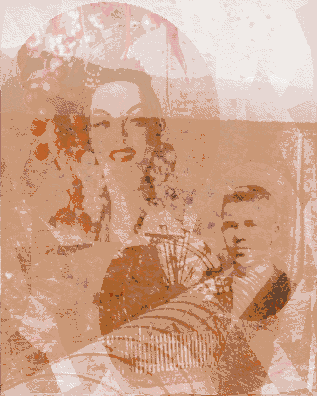
The creation of Willing Stars' name does represent a fictional synthesis of sorts. We
know very little about Chumash religious practices because this culture was the first to
be destroyed by the mission system. However, A.L. Kroeber's Handbook of the
Indians of California and other texts stress some important points. The California
tribes were not homogenous in any sense. Some 135 different languages were spoken
by these native groups. The languages belong to 21 different linguistic families.
Kroeber believed that many of the tribes were the product of in-migration and that
they brought cultural practices with them. Once in California, tribes seemed to occupy
specific environmental niche areas that persisted over some time and were clearly
understood by neighbors. From these areas, they traded both goods and ideas (and
often words, though they spoke separate root languages). So, for example, we know
a fair amount about the Penutian-speaking group, the Yokuts, of the San Joaquin
Valley. We know they had both a "sweat house" tradition and also a not-too-clearly
elaborated female initiation ceremony that seemed to have come from the Chumash
(Hokan-speaking). Just to the south of the Chumash were two Shoshonean-speaking
tribes: the Gabrielenos and the Luisenos. These groups had a very elaborate mystical
tradition, complete with shaman and shamaness categories and jimson-weed rituals -
rites they seemed to have shared with the Chumash. Also, we have the extensive
pictographs of the Chumash and the evidence from E.C. Krupp (Echoes of the
Ancient Skies) that the caves were associated with the solstices and star journeys.
One of the ubiquitous graphics in the cave paintings is the spider web. I imagined a
woman shaman who was associated with the web of the stars. In fact, the Gabrieleno,
Fernandeno, Serrano, and Yokut each had a name for such a woman. Kroeber
speculates that the Chumash must have had a similar figure. The name is some
variation of Chukit or Ukat. I have taken the native language base, made an
amalgamation, and given Willing Stars a name "not of the conqueror." Translated
roughly, UKAT-CHOKUN-HOWISH-NOCUMA means "Spirit One Who Weaves
the Skirt of the Web of Willing Stars." The etymology of the name is explained in The
Journey South, Kaye's Path.

The escape of the native Chumash,Yokut, and other tribes from Fort Tejon to Owens
Valley is also well documented, notably in The Destruction of California Indians by
Robert F. Heizer. Calvin relates this section of the story as a Docudrama (2), using
letters that closely parallel the actual correspondence between the Indian Agent and
the State Commissioner in 1858 and 1859. The Docudramas represent a different
approach to problematic history and memory. Calvin is the organizer in Califia, and,
as such, he represents a kind of official voice; he arranges and interprets the material,
making it into what appears to be a legitimate history. Nevertheless, the Docudramas
exist simultaneously with other personal narratives about the same events (Kaye's, and
those of Rosalind Summerland, La Reina Lugo, and Nellie Clare Beveridge). While
the different versions do not contradict, they illustrate how point of view can determine
the experience of reality. Calvin, working with hard copy, constructs a linear story that
coincides with the facts - but is not always the entire truth within the novel.
If you are having any
trouble accessing Califia, or you need help finding your way around,
please contact me. I would, of course, appreciate any feedback you
have about the novel!
Continue with Lecture XIV.
|








